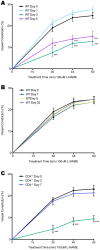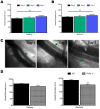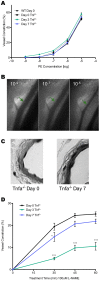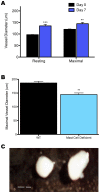Nitric oxide and TNFα are critical regulators of reversible lymph node vascular remodeling and adaptive immune response
- PMID: 23573281
- PMCID: PMC3616017
- DOI: 10.1371/journal.pone.0060741
Nitric oxide and TNFα are critical regulators of reversible lymph node vascular remodeling and adaptive immune response
Abstract
Lymph node (LN) vascular growth, at the level of the main arteriole, was recently characterized for the first time during infection. Arteriole diameter was shown to increase for at least seven days and to occur via a CD4(+) T cell dependent mechanism, with vascular expansion playing a critical role in regulating induction of adaptive immune response. Here, using intravital microscopy of the inguinal LN during herpes simplex type II (HSV-2) infection, the data provides the first studies that demonstrate arteriole expansion during infection is a reversible vascular event that occurs via eutrophic outward remodeling. Furthermore, using genetic ablation models, and pharmacological blockade, we reveal arteriole remodeling and LN hypertrophy to be dependent upon both endothelial nitric oxide synthase (eNOS) and TNFα expression. Additionally, we reveal transient changes in nitric oxide (NO) levels to be a notable feature of response to viral infection and LN vascular remodeling and provide evidence that mast cells are the critical source of TNFα required to drive arteriole remodeling. Overall, this study is the first to fully characterize LN arteriole vascular changes throughout the course of infection. It effectively reveals a novel role for NO and TNFα in LN cellularity and changes in LN vascularity, which represent key advances in understanding LN vascular physiology and adaptive immune response.
Conflict of interest statement
Figures







Similar articles
-
Contribution of nitric oxide synthase isoforms to cholinergic vasodilation in murine retinal arterioles.Exp Eye Res. 2013 Apr;109:60-6. doi: 10.1016/j.exer.2013.01.012. Epub 2013 Feb 19. Exp Eye Res. 2013. PMID: 23434456
-
Intravital microscopy of the inguinal lymph node.J Vis Exp. 2011 Apr 4;(50):2551. doi: 10.3791/2551. J Vis Exp. 2011. PMID: 21490584 Free PMC article.
-
Role of nitric oxide synthase isoforms for ophthalmic artery reactivity in mice.Exp Eye Res. 2014 Oct;127:1-8. doi: 10.1016/j.exer.2014.06.018. Epub 2014 Jul 10. Exp Eye Res. 2014. PMID: 25017185
-
The estrogen effects on endothelial repair and mitogen-activated protein kinase activation are abolished in endothelial nitric-oxide (NO) synthase knockout mice, but not by NO synthase inhibition by N-nitro-L-arginine methyl ester.Am J Pathol. 2008 Mar;172(3):830-8. doi: 10.2353/ajpath.2008.070439. Epub 2008 Feb 14. Am J Pathol. 2008. PMID: 18276789 Free PMC article.
-
Aging-related endothelial dysfunction in the aorta from female senescence-accelerated mice is associated with decreased nitric oxide synthase expression.Exp Gerontol. 2013 Nov;48(11):1329-37. doi: 10.1016/j.exger.2013.08.003. Epub 2013 Aug 13. Exp Gerontol. 2013. PMID: 23948180
Cited by
-
Lymph-directed nitric oxide increases immune cell access to lymph-borne nanoscale solutes.Biomaterials. 2021 Jan;265:120411. doi: 10.1016/j.biomaterials.2020.120411. Epub 2020 Sep 18. Biomaterials. 2021. PMID: 33080460 Free PMC article.
-
Power Doppler ultrasonographic assessment of the joint-draining lymph node complex in rheumatoid arthritis: a prospective, proof-of-concept study on treatment with tumor necrosis factor inhibitors.Arthritis Res Ther. 2016 Oct 22;18(1):242. doi: 10.1186/s13075-016-1142-7. Arthritis Res Ther. 2016. PMID: 27770827 Free PMC article.
-
Anti-oxidative and anti-inflammatory effects of Tagetes minuta essential oil in activated macrophages.Asian Pac J Trop Biomed. 2014 Mar;4(3):219-27. doi: 10.1016/S2221-1691(14)60235-5. Asian Pac J Trop Biomed. 2014. PMID: 25182441 Free PMC article.
-
Downregulation of L-arginine metabolism in dendritic cells induces tolerance to exogenous antigen.Int J Immunopathol Pharmacol. 2017 Mar;30(1):44-57. doi: 10.1177/0394632016678873. Epub 2017 Jan 24. Int J Immunopathol Pharmacol. 2017. PMID: 27903843 Free PMC article.
-
Effects of intratracheally instilled laser printer-emitted engineered nanoparticles in a mouse model: A case study of toxicological implications from nanomaterials released during consumer use.NanoImpact. 2016 Jan;1:1-8. doi: 10.1016/j.impact.2015.12.001. Epub 2016 Jan 21. NanoImpact. 2016. PMID: 26989787 Free PMC article.
References
-
- von Andrian UH, Mempel TR (2003) Homing and cellular traffic in lymph nodes. Nat Rev Immunol 3: 867–878. - PubMed
-
- Miyasaka M, Tanaka T (2004) Lymphocyte trafficking across high endothelial venules: dogmas and enigmas. Nat Rev Immunol 4: 360–370. - PubMed
-
- Marchesi VT, Gowans JL (1964) The Migration of Lymphocytes through the Endothelium of Venules in Lymph Nodes: An Electron Microscope Study. Proc R Soc Lond B Biol Sci 159: 283–290. - PubMed
-
- von Andrian UH (1996) Intravital microscopy of the peripheral lymph node microcirculation in mice. Microcirculation 3: 287–300. - PubMed
Publication types
MeSH terms
Substances
Grants and funding
LinkOut - more resources
Full Text Sources
Other Literature Sources
Research Materials

